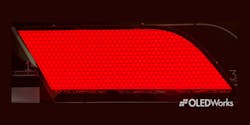They say that a picture’s worth a thousand words. Writers such as the one scribbling this article would like to believe the opposite — that one well-chosen word is worth a thousand pictures.
But as many times as we’ve written about the potential for OLED technology to change the face of automotive lighting, we have to admit that the short video clip posted below speaks volumes.
It comes from OLED maker OLEDWorks, and shows what we have mentioned in the past — that OLED tail lights can be used to flash warning signs to other motorists about road and traffic conditions and other hazards.
A ticker tape of snowflakes warns of icy conditions. (Video credit: Clip courtesy of OLEDWorks.)
OLEDWorks recorded the clip at its CES booth last week in Las Vegas, where the annual consumer electronics show resumed live a year after it went online-only for pandemic reasons
If you have a second, go ahead and rubberneck it. Spoiler: It shows a line of snowflakes quickly streaming and flashing the length of a tail light. In any real world deployment on the road — as opposed to last week’s disembodied housing on a countertop — a trailing motorist would know to take care, if they didn’t know that already.
The feature is an improved version over what OLEDWorks had previously developed, as the company said it is now using 600 OLED segments per panel, way up from the earlier 40–60 units.
“As the number of segments increases, OLED panels can display increasingly complex images and symbols — and therefore more comprehensive information — to nearby vehicles, effectively increasing safety on the road,” the company said.
OLEDWorks, based in Rochester, NY, is an intrepid champion of the many possible uses for OLEDs. As is often the case with its announcements, blogs, and demos, the CES display did not come with any commercial news of note. That is, no car maker was on hand to say it was putting the warning feature into next year’s model.
But OLEDWorks has been slowly working its wares into the automotive world. Germany’s Audi has built OLED tail lights into a few select models, most recently as a standard feature on the A8 luxury sedan. Its suppliers are believed to include OLEDWorks.
The Audi models do not include the hazard light feature that OLEDWorks showed at CES, but it seems likely that Audi will eventually add that aspect to its OLED tail lights. Today, Audi taps the technology to enable sleeker designs, customized “signatures,” and to warn other motorists if they are getting too close the car in front of them.
OLEDs are thin patches of materials that light up in response to a current; by comparison LEDs are single point light sources. Advocates say OLEDs provide more design possibilities than LEDs, although LED designers have themselves made advances in integrating into thin materials.
Audi head of rear lamp development Michael Kruppa notes in a separate OLEDWorks video that OLEDs take up less room than LEDs.
He also points out that OLEDs are a “surface light source, so you don’t have to scatter the light which is being emitted from a point light source.” Consequently, “you have a perfect intrinsic optical efficiency, which is way better than any LED solution,” Kruppa says, adding that OLEDs also offer superior dark-light performance. But he stopped short of describing any supply agreement with OLEDWorks.
MARK HALPER is a contributing editor for LEDs Magazine, and an energy, technology, and business journalist ([email protected]).
For up-to-the-minute LED and SSL updates, why not follow us on Twitter? You’ll find curated content and commentary, as well as information on industry events, webcasts, and surveys on our LinkedIn Company Page and our Facebook page.






